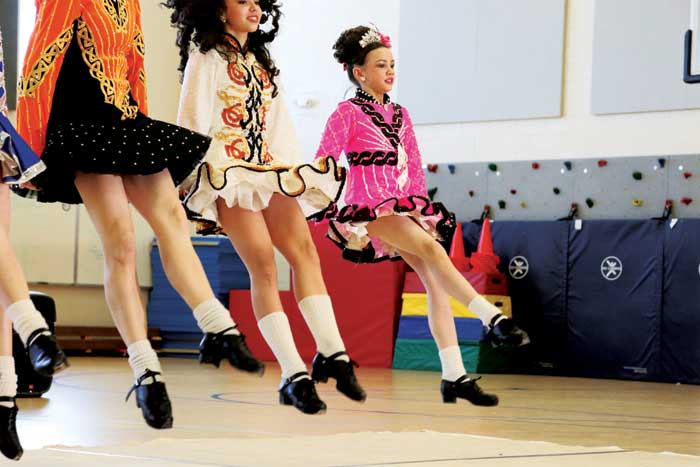
On St. Patrick’s Day, Christina Doolan, 11, performs at McAuliffe Middle School with other dancers from her school, the Wick School of Irish Dance in Denver.
Christina Doolan, 11, excitedly awaits her departure for London April 7 to perform at an international Irish Dance competition. “I’m looking forward to London and being in this big of a competition,” she says.
Doolan qualified for the competition by placing sixth at Oireachtas—the Western Regional Championship held in Phoenix this year. To qualify she needed to place in the top 11.
Irish dancers often begin taking lessons when they are between 5 and 8 years old. Doolan started five years ago with the Wick School of Irish Dance. Beginner dancers at each school wear the same dress—Wick students wear yellow and blue dresses with traditional Celtic designs.
Three years ago Doolan advanced to the championship level, which is when she “really got intense about dance.” The level involves more solo dancing and travel competitions. Plus, she wears a personalized dress.
“It’s pink with lots of sparkles. I love pink, but also green and blue.” When she outgrows this dress, she plans to wear a pink and orange dress.
Dresses are costly, which is just one of many expenses—classes, competitions, shoes and more.
The type of dance has several quirks. Research shows the very nature of Irish Dance is rather unusual. One author says the Catholic Church disapproved of dancing in early Irish times. People developed the style of dance to keep the upper body still so that when a priest walked by and glanced in a window he could not tell if someone was dancing.
Contemporary dancers wear wigs—some a bun wig like Doolan and others a voluminous wig that covers the whole head. “My head is too small for it. It’s overwhelming to wear,” Doolan says.
During competitions, dancers glue their socks to their legs to keep them from falling down and tan their legs so judges can easily see them.
Doolan will compete against 11-year-olds from around the world. “I like Irish Dance because I’ve made a lot of friends and it’s a lot of fun to dance.”



0 Comments